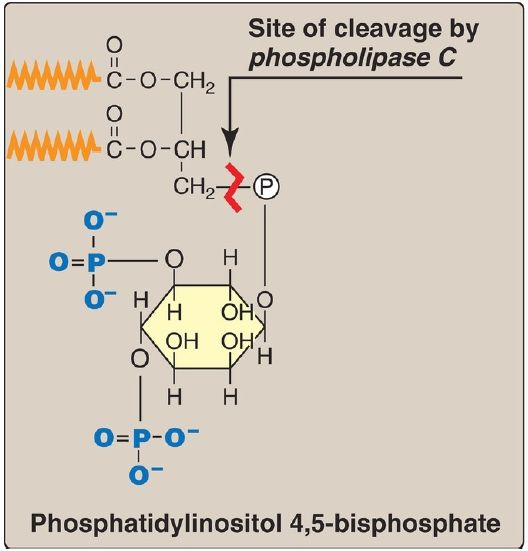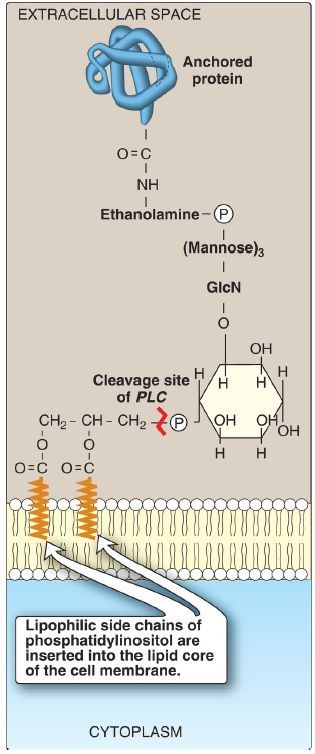


 النبات
النبات
 الحيوان
الحيوان
 الأحياء المجهرية
الأحياء المجهرية
 علم الأمراض
علم الأمراض
 التقانة الإحيائية
التقانة الإحيائية
 التقنية الحيوية المكروبية
التقنية الحيوية المكروبية
 التقنية الحياتية النانوية
التقنية الحياتية النانوية
 علم الأجنة
علم الأجنة
 الأحياء الجزيئي
الأحياء الجزيئي
 علم وظائف الأعضاء
علم وظائف الأعضاء
 الغدد
الغدد
 المضادات الحيوية
المضادات الحيوية|
Read More
Date: 5-9-2021
Date: 9-11-2021
Date: 7-1-2022
|
Phosphatidylinositol
PI is synthesized from free inositol and CDP-DAG, as shown in Figure 1. PI is an unusual phospholipid in that it most frequently contains stearic acid on carbon 1 and arachidonic acid on carbon 2 of the glycerol.
Therefore, PI serves as a reservoir of arachidonic acid in membranes and, thus, provides the substrate for prostaglandin synthesis when required. Like PS, PI has a net negative charge. [Note: There is asymmetry in the phospholipid composition of the cell membrane. PS and PI, for example, are found primarily on the inner leaflet. Asymmetry is achieved by ATP-dependent enzymes known as “flippases” and “floppases.”]
1. Role in signal transduction across membranes: The phosphorylation of membrane-bound PI produces polyphosphoinositides such as phosphatidylinositol 4,5-bisphosphate ([PIP2]; Fig. 1). The cleavage of PIP2 by phospholipase C occurs in response to the binding of various neurotransmitters, hormones, and growth factors to G protein–coupled receptors (GPCR), such as the α1 adrenergic receptor, on the cell membrane and activation of the Gq α-subunit (Fig. 2). The products of this cleavage, inositol 1,4,5-trisphosphate (IP3) and DAG, mediate the mobilization of intracellular calcium and the activation of protein kinase C, which act synergistically to evoke specific cellular responses. Signal transduction across the membrane is, thus, accomplished.

Figure 1: Structure of phosphatidylinositol 4,5-bisphosphate (PIP2). Cleavage by phospholipase C produces inositol 1,4,5-trisphosphate (IP3) and diacylglycerol. ( is a fatty acid hydrocarbon chain.) = phosphate.

Figure 2: Role of inositol triphosphate and diacylglycerol in cell signaling. GDP and GTP = guanosine di- and triphosphates; Ca2+ = calcium.
2. Role in membrane protein anchoring: Specific proteins can be covalently attached through a carbohydrate bridge to membrane-bound PI (Fig. 3). For example, lipoprotein lipase, an enzyme that degrades triacylglycerol in lipoprotein particlesis attached to capillary endothelial cells by a glycosyl phosphatidylinositol (GPI) anchor. [Note: GPI-linked proteins are also found in a variety of parasitic protozoans, such as trypanosomes and leishmania.] Being attached to a membrane lipid (rather than being an integral part of the membrane) allows GPI-anchored proteins increased lateral mobility on the extracellular surface of the plasma membrane. The protein can be cleaved from its anchor by the action of phospholipase C (see Fig. 3).
[Note: A deficiency in the synthesis of GPI in hematopoietic cells results in the hemolytic disease paroxysmal nocturnal hemoglobinuria, because GPI-anchored proteins protect blood cells from complement-mediated lysis.]

Figure 3: Example of a glycosyl phosphatidylinositol (GPI) membrane protein anchor. GlcN = glucosamine; = phosphate; PLC = phospholipase C.



|
|
|
|
تحذير من "عادة" خلال تنظيف اللسان.. خطيرة على القلب
|
|
|
|
|
|
|
دراسة علمية تحذر من علاقات حب "اصطناعية" ؟!
|
|
|
|
|
|
|
العتبة العباسية المقدسة تحذّر من خطورة الحرب الثقافية والأخلاقية التي تستهدف المجتمع الإسلاميّ
|
|
|